Each year, thousands of lives are impacted by the deadly disease known as small cell lung cancer (SCLC). It is critical for patients, families, and medical professionals to understand the survival statistics linked to this aggressive form of cancer. We’ll examine the complexities of small cell lung cancer survival rates in this post, as well as the factors that affect them and the state of research and therapy at the moment.
Understanding Small Cell Lung Cancer
Small cell lung cancer (SCLC) is a highly aggressive form of lung cancer that demands attention and understanding. It is crucial to comprehend the factors influencing the survival rate to better grasp the challenges and possibilities associated with this disease.
Factors Influencing Survival Rates
Survival rates can be influenced by various factors, depending on the context. In medical scenarios, factors affecting survival might include:
- Stage of Cancer: The stage at which small cell lung cancer is diagnosed significantly impacts survival rates. Generally, earlier stages offer a more favorable prognosis, as the cancer is localized and potentially curable through surgical intervention.
- Treatment Approach: The chosen treatment modality, whether it be surgery, chemotherapy, radiation therapy, or a combination thereof, plays a pivotal role in determining survival outcomes. Advancements in treatment options and personalized medicine have contributed to improved survival rates in recent years.
- Patient Factors: Individual characteristics, such as age, overall health status, and lifestyle choices, can influence how well a patient responds to treatment and their overall prognosis.
Survival Rates for Small Cell Lung Cancer
Survival rates for small cell lung cancer (SCLC) can vary depending on several factors, including the stage of the cancer at diagnosis, the patient’s overall health, and the effectiveness of treatment. Generally, SCLC is known for its aggressive nature and tendency to spread rapidly, which can impact survival rates.
Stage-specific Survival Rates
Stage-specific survival rates for small cell lung cancer (SCLC) are typically categorized into two main stages: limited stage and extensive stage. Here are the stage-specific survival rates for SCLC:
- Limited Stage: Small cell lung cancer diagnosed at an early or limited stage, where it is confined to one lung and potentially nearby lymph nodes, typically presents a more favorable prognosis. The five-year survival rate for limited-stage SCLC ranges from approximately 15% to 30%, highlighting the importance of early detection and prompt intervention.
- Extensive Stage: When small cell lung cancer has spread beyond the confines of the affected lung to distant sites in the body, it is categorized as extensive stage SCLC. Despite advancements in treatment, the five-year survival rate for extensive-stage SCLC remains relatively low, typically ranging from 2% to 5%. However, ongoing research and clinical trials offer hope for improving outcomes in this challenging scenario.
Trends and Prognostic Factors
Survival rates for small cell lung cancer have shown modest improvements over the years, reflecting advancements in treatment approaches and supportive care measures. Factors such as smoking cessation, early detection through screening programs, and access to comprehensive cancer care facilities also contribute to enhanced survival outcomes.
Advances in Small Cell Lung Cancer Research
In the dynamic field of small cell lung cancer (SCLC) research, progress is driven by promising treatments and ongoing clinical trials.
Promising Treatments
Researchers are investigating new pharmacological treatments intended to more precisely target SCLC cells. Using the body’s immune system, immunotherapy has the potential to strengthen the body’s defenses against SCLC. With a focus on certain biochemical pathways, targeted treatments seek to more precisely impede the proliferation of cancer cells. The potential for synergistic benefits between immunotherapy, targeted treatments, and chemotherapy is being explored.
Ongoing Clinical Trials
Clinical trials are essential to innovation because they test new treatments. They evaluate the safety, effectiveness, and possible adverse effects in a range of patient populations, providing important information to improve treatment regimens. In addition to giving patients access to state-of-the-art therapies, clinical trial participation advances our knowledge of SCLC.
The advancement in SCLC research is fueled by the combination of potential medicines and continuing clinical trials, which offers optimism for revolutionary breakthroughs in treatment techniques.
Coping Strategies and Support
It is certainly difficult for the patient and their loved ones to deal with a small cell lung cancer diagnosis. In order to successfully navigate the mental and physical parts of this journey, coping mechanisms and a strong support network are essential.
- Support Groups: Participating in support groups may provide people access to priceless emotional support by enabling them to discuss their experiences and coping techniques. This sense of belonging to a group helps people become resilient and face the unknowns that come with small cell lung cancer.
- Mental Health Resources: Given the psychological impact of receiving a cancer diagnosis, it’s critical to have access to mental health resources. Therapy and counselling can help manage depression, anxiety, and stress, which can enhance one’s quality of life overall.
Conclusion
In conclusion, understanding the small cell lung cancer survival rate involves a multifaceted exploration of various factors. From timely diagnosis and treatment to ongoing research initiatives, the landscape is dynamic and continually evolving. By staying informed and embracing support, individuals and their families can navigate this challenging journey with resilience.
Visit here for more information: Leukocytosis icd 10 | Lump under chin near throat
